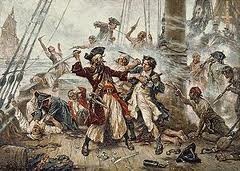
About Ocracoke
One of the barrier islands of the "Outer Banks" of North Carolina, Ocracoke Island is 16 miles long, and bordered by the Pamlico Sound on the the west and the Atlantic Ocean on the east. This geographical location offers a nature lover's paradise with excellent fishing, water sports, birdwatching, and of course beach combing. Island Activities Fishing Info
The village of Ocracoke is located on the southern end of the island and makes up approximately 10% of the island land mass. All the privately owned land is in the village. The remaining 90% of land mass and all of the beach is owned and maintained by the U.S. Park Service. There are no hotels, high rises, shops, or restaurants of any kind along our ocean front. This makes for beautiful, unspoiled beaches which are annually ranked among America's best.
The island is only accessible by private boat, plane, or one of three state-run ferries. This limited access has helped preserve the original Outer Banks charm and way of life that residents and vacationers have enjoyed over the years.
Historical accounts show that with proximity to a navigable inlet, Ocracoke and neighboring Portsmouth Villages both grew as port towns with increased goods being shipped across the Pamlico Sound and up North Carolina rivers. With increased trade came opportunity for residents but also thieves such as Edward Teach, better known as Blackbeard the Pirate. He lived, pirated, and met his end on the waters surrounding Ocracoke Island. Nearby is Teach's Hole, the site where Blackbeard died in hand-to-hand combat with members of the Royal Navy on November 22, 1718. Legend has it that some of his treasures are still buried on the island.
The Ocracoke Lighthouse was established in 1823 to help guide ships along the area off the North Carolina coast known as the Graveyard of the Atlantic. It is the oldest continuously operating lighthouse on the East Coast. It stood tall during both the Civil and World Wars helping mariners with passage along the treacherous coastline. Shipwrecks are still occasionally uncovered in the ever shifting sands along Ocracoke's beaches.
World War II was witnessed firsthand on the Island with German U-boats cruising just offshore and sinking many ships. The British Cemetery on Ocracoke serves as a reminder of this time with the crew of the HMC Bedfordshire buried here. Islanders found the sailor's bodies washed ashore and took them back to the village for proper burial. A US Navy Base was established briefly on the island in the Coast Guard Station as well as an additional structure out near the beach to listen for submarine activity by way of a long underwater cable.
After the War, the island was still relatively isolated with the daily mail boat being the only contact to the mainland. Wealthy hunters and fisherman had been traveling to the island for the sporting possibilities for years and eventually realized that their families would enjoy the beaches and other activities that Ocracoke had to offer. Some adventurous families made the trip, but not until Highway 12 was paved and normal ferry service was offered in 1957 did Ocracoke begin it's path to the charming tourist destination that we know today.






